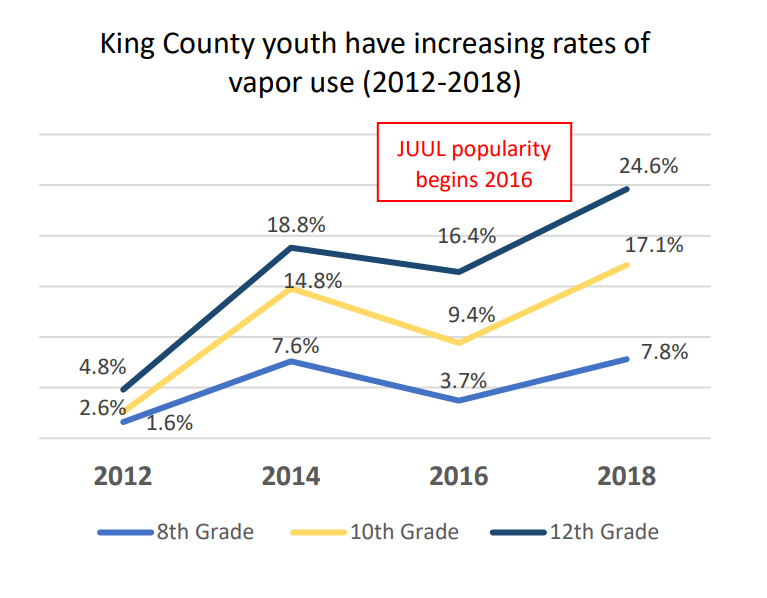E-cigarettes and vapor products
Electronic smoking devices or e-cigarettes are battery operated devices used to inhale a vaporized liquid solution that frequently contain nicotine, flavorings and other chemicals. Because the liquid solution is converted into an aerosol vapor, e-cigarette use is often referred to as "vaping," rather than smoking.
Parts of a JUUL cigarette
Related article from the Public Health Insider:
How JUUL cornered the youth tobacco market and what you should know

Parts of a vape pen
Related article from the Public Health Insider:
Flavored tobacco: Candy-coated addiction

E-cigarette varieties
Related article from the Public Health Insider:
Not just water vapor: Why e-cigarettes are so dangerous

E-cigarette and e-liquid varieties
Related article from the Public Health Insider:
Flavored tobacco: Candy-coated addiction

⬇︎ Select a topic to expand view
While e-cigarettes do not contain tobacco, they often contain nicotine.
- The main harm from nicotine is addiction: Nicotine is highly addictive.1,2
- People addicted to nicotine can experience significant physical and psychological withdrawal symptoms when they try to stop using nicotine.
- Nicotine is harmful during pregnancy. It can lead to babies born at low birth weight, preterm delivery and stillbirth.3
- Nicotine raises heart rate and blood pressure4 and may damage blood vessels and heart muscle.5
- Health impacts of e-cigarettes (1.3 Mb), WA State Dept. of Health
- Hallazgos sobre el impacto de los cigarrillos electrónicos en la salud (Spanish, 464 Kb), WA State Dept. of Health
Youth are especially vulnerable to the toxic effects of nicotine.
- The younger one starts using nicotine, the more likely you will become addicted.6
- Nicotine use during adolescence may have long-lasting effects on brain function, including thinking and behavior.1
- Nicotine use in e-cigarettes may predispose youth towards using tobacco products.7,8,9
Nicotine is toxic if spilled on skin or ingested in liquid form.
- Many refillable liquid nicotine (e-juice) bottles come in easy to open packaging that is not child-resistant.
- In 2018, the Washington Poison Center received a total of 129 e-cigarette exposures. 79 of these cases were in children 0-25 years old and 23 were in youth 13-20 years old. Common exposures for children included playing with vape pens, opening the liquid nicotine bottle and getting it on their hands, or drinking directly from liquid nicotine bottles. The best way to prevent this is to securely store e-cigarette and vape products and to keep them out of reach of children.10
Research on health effects of secondhand exposure to e-cigarettes is still emerging. However, initial studies have shown the vapor contains carcinogens. The quantity of these carcinogens is less that what is found in conventional cigarettes.
- E-cigarette may cause secondhand vaping.11,12,13
- The vapor contains several carcinogens, such as formaldehyde, acetaldehyde, lead, nickel, and chromium.14,15,16
- However, the quantity of these harmful compounds is often less than what is found in conventional cigarette smoke.17
- Sodium, iron, aluminum, and nickel have been found in higher concentrations than in cigarette smoke and are associated with lung irritation, shortness of breath, and chronic bronchitis.18
- E-cigarettes have not been scientifically proven to help smokers quit or reduce consumption of traditional cigarettes.19,20
- E-cigarettes have not been proven safe or effective by the Food and Drug Administration as a quit smoking aid (cessation device).
- Smokers wishing to quit can find out safe and effective options for quitting tobacco.
E-cigarette manufacturers are using marketing tactics used by the tobacco industry to lure kids to conventional cigarettes. Their tactics include slick magazine ads, sponsorship of concerts and auto races, celebrity endorsements and sweet, colorful flavors.21 In addition, e-cigarettes are often aggressively placed in convenience stores near candy.
Refillable liquid nicotine solutions are available in thousands of flavors. Many of the flavors appeal specifically to youth and even use the same brand names as kids' candy, ice cream, cereal products or other treats.22

E-cigarette use among youth is growing both nationally and locally. In King County, youth e-cigarette use is now higher than the use of conventional cigarettes.

Federal
- Federal law now prohibits the sale of tobacco or vapor products to anyone under age 21.
- Currently, there is no federal oversight or safety checks for what e-cigarettes contain.
- Some liquid nicotine juices or cartridges claim to have no nicotine. However, product testing has revealed that the information and ingredients listed on the packaging of e-cigarettes can be misleading or incorrect.23
Prohibits the sale of e-cigarettes to people under 21 years of age.
King County
- Vaping or use of e-cigarettes in public places and places of employment is prohibited, just like smoking.
- Sale of e-cigarettes and nicotine products to minors under 18 years of age is prohibited.
- Sampling of e-cigarettes or nicotine e-juices is prohibited.
References
1 C Everett Koop, M., Health Consequences of Smoking: Nicotine Addiction a Report of the Surgeon General 1988. 1988: DIANE Publishing.
2 Diagnosis Dictionary - Nicotine. Psychology Today.
3 US Department of Health Human Services, The health consequences of smoking—50 years of progress: A report of the Surgeon General, in Atlanta, GA: US Department of Health and Human Services, Centers for Disease Control and Prevention, National Center for Chronic Disease Prevention and Health Promotion, Office on Smoking and Health. 2014.
4 US Department of Health Human Services, How tobacco smoke causes disease: the biology and behavioral basis for smoking attributable disease: a report of the Surgeon General. Atlanta, GA:US Department of Health and Human Services, Centers for Disease Control and Prevention, National Center for Chronic Disease Prevention and Health Promotion, Office on Smoking and Health, 2010. 2
5 Bhatnagar A, et al. Electronic cigarettes: a policy statement from the American Heart Association. Circulation. 2014 Oct 14;130(16):1418-36.
6 Nicotine Addiction and Your Health, U.S. Department of Health & Human Services. (July 3, 2015).
7 US Department of Health Human Services, The health consequences of smoking—50 years of progress: A report of the Surgeon General, in Atlanta, GA: US Department of Health and Human Services, Centers for Disease Control and Prevention, National Center for Chronic Disease Prevention and Health Promotion, Office on Smoking and Health. 2014.
8 Centers for Disease Control and Prevention, Incidence of initiation of cigarette smoking—United States, 1965-1996. MMWR. Morbidity and mortality weekly report, 1998. 47(39): p. 837.
9 US Department of Health Human Services, Preventing tobacco use among youth and young adults: A report of the Surgeon General.Atlanta, GA: US Department of Health and Human Services, Centers for Disease Control and Prevention, National Center for Chronic Disease Prevention and Health Promotion, Office on Smoking and Health, 2012. 3.
10 Washington Poison Center (2018) Annual Data Report.
11 Schripp, T., Markewitz, D., Uhde, E., & Salthammer, T. (2013). Does e-cigarette consumption cause passive vaping? Indoor Air. 23(1), 25–31.Doi:10.1111/j.1600-0668.2012.00792.x
12 Schober, W, et al. (2013). Use of electronic cigarettes (e-cigarettes) impairs indoor air quality and increases FeNO levels of e-cigarette consumers. International Journal of Hygiene and Environmental Health.
13 Czogala, J., et al. (2013). Secondhand Exposure to Vapors From Electronic Cigarettes. Nicotine & Tobacco Research, 2013.
14 The Center for Environmental Health, A Smoking Gun: Cancer-causing chemicals in e-cigarettes, 2015
15 State of California Environmental Protection Agency Office of Environmental Health Hazard Assessment Safe Drinking Water and Toxic Enforcement Act of 1986. (2013).Chemicals known to the State of California to cause cancer or reproductive toxicity.
16 Goniewicz, M. et al. (2013). Levels of selected carcinogens and toxicants in vapour from electronic cigarettes. Tob. Control. 1:1–8.
17 Goniewicz, M. et al. (2013). Levels of selected carcinogens and toxicants in vapour from electronic cigarettes. Tob. Control. 1:1–8.
18 Williams, M., Villarreal, A., Bozhilov, K., Lin, S., & Talbot, P. (2013). Metal and silicate particles including nanoparticles are present in electronic cigarette cartomizer fluid and aerosol. PloS one, 8(3), e57987. doi:10.1371/journal.pone.0057987.
19 Dutra, L.M. and S.A. Glantz, Electronic Cigarettes and Conventional Cigarette Use Among US Adolescents: A Cross-sectional Study. JAMA Pediatr, 2014.
20 Grana, R., Benowitz, N., & Glantz, S. A. (2014). E-Cigarettes: A Scientific Review. Circulation, 129(19), 1972–1986.
21 Campaign For Tobacco-Free Kids. (2015). E-Cigarette Marketing Continues to Mirror Cigarette Marketing.
22 Campaign for Tobacco-Free Kids. (2014). Nine E-Juice Flavors That Sound Just Like Kids' Favorite Treats.
23 For example, the vaporized solution that people who use e-cigarettes inhale often contains nicotine levels that are different from their labeling. Two separate studies found that the nicotine levels of two individual products were over 20% higher than what their labeling indicated. See: Etter, Jean-François, Eva Zäther, and Sofie Svensson. Analysis of Refill Liquids for Electronic Cigarettes. Addiction (May 23, 2013): 1–9. doi:10.1111/add.12235.; Goniewicz, Maciej L, Tomasz Kuma, Michal Gawron, Jakub Knysak, and Leon Kosmider. Nicotine Levels in Electronic Cigarettes. Nicotine & Tobacco Research: Official Journal of the Society for Research on Nicotine and Tobacco 15, no. 1 (January 2013): 158–66. doi:10.1093/ntr/nts103.

 Translate
Translate